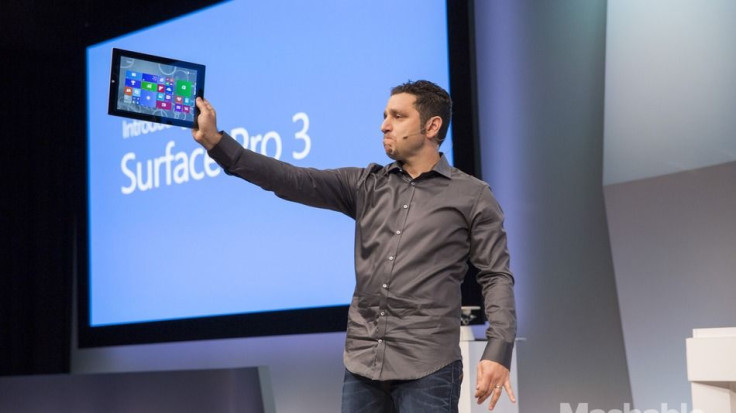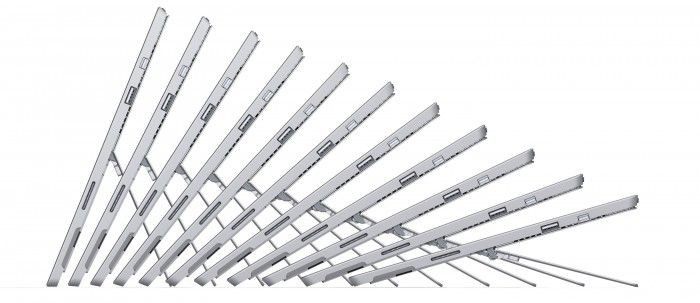Microsoft Surface Pro 3 Announced: One Device To Answer Two Needs [VIDEO]

For the estimated 96 percent of people who own a tablet as well as a laptop, Microsoft Tuesday introduced a one-device solution: the Surface Pro 3.
Panos Panay, corporate vice president with Microsoft's Surface division, hit the stage Tuesday morning at a small press event at Internet Week in New York to announce the tech giant’s answer to the problem of having two devices. The 12-inch Surface Pro 3 tablet line, encompassing a range of models with processors from the Intel Core i3 to the i7, will be available starting Wednesday, May 21, priced at $799 and up.
“Three years ago, tablets were supposed to kill the laptop,” Panay said before announcing the next generation of Microsoft’s tablet. But it hasn't happened, because there's a conflict in the world of computing, he contended. Tablets are for consumption – watching movies, reading books and playing games -- whereas laptops are for productivity – doctors, architects, creatives like writers and artists all use laptops to create.
The Surface Pro 3, a 12-inch tablet tagged as “the tablet that can replace your laptop,” is a crossover device, taking the best from both worlds with sacrificing from neither, according to Panay.
The first thing that's noteworthy about the Surface Pro 3 is the size. At 12 inches, the device is about 13 percent larger than the Surface Pro 2, a tablet that got many mixed reviews and relatively negligible initial sales. However, Panay notes that the weight and width (read thin) come in lower than the Surface Pro 2. At 800 grams and 9.1 mm, the device is surprisingly thin and light.
“And that is by design,” Panay beams. He cheered the multiple design teams throughout the presentation.
Panay takes the device and places it on a scale, one that brings back memories from sophomore year biology. He then picks up an Apple MacBook Air, famous for its size and weight, and places it on the other side of the scale. The Surface Pro 3 rises with ease. However, he doesn’t stop there as he pulls out an iPad Air and places it on top of the MacBook Air. He drives the 96 percent statistic home.
The Surface Pro 3 is comparable to the MacBook Air due to its capabilities and size. Despite have an inch less of screen real estate, “on the 12-inch screen you get 6 percent more content than on the 13-inch MacBook Air,” Panay states. That's because the screen has a hoard of new improvements.
Lightness is a big one. The Surface Pro 3 is the “thinnest [Intel] Core product ever,” Panay said. Performance-wise, Microsoft partnered with Intel to get 10 percent more performance out of the Surface Pro 3 when compared to the previous model, the Surface Pro 2. And to make the device usable for both work and play, a docking station that outputs to 4k monitors and an innovative hinged kickstand were added.

The kickstand “does a lot for a tablet,” Panay said, showing it in the 22-degree angle that the Surface Pro 2 had. The development team was able to design a hinge capable of up to 150-degree angles with “full-friction,” meaning the hinge can be pushed and pulled with resistance. Panay displayed the device in several positions on both a desk and his lap, calling it “lapability.” An improved keyboard cover is available in multiple colors, and enhances the lapability of the device.
Perhaps the most interesting feature of the device is the pen -- “Don’t call it a stylus,” said Panay. By including something Microsoft is calling “Palm Block,” Surface Pro 3 users will be able to rest their hands on the device naturally, much like they do on a piece of paper.
“It’s what makes it familiar, it’s what makes it personal,” Panay said as he wrote notes on images and scripts in OneNote and FinalDraft, a script-writing software once synonymous with Apple. “Tablets have to be personal.”
The feature Microsoft touted most is that the Surface Pro 3 pen can activate the device with a click of a button, much like clicking a real pen into action. Instant-on capability brings up Microsoft OneNote, allowing users to journal and write instantaneously.
© Copyright IBTimes 2024. All rights reserved.



















